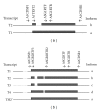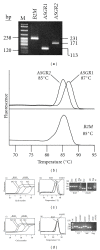ASGR1 and ASGR2, the Genes that Encode the Asialoglycoprotein Receptor (Ashwell Receptor), Are Expressed in Peripheral Blood Monocytes and Show Interindividual Differences in Transcript Profile
- PMID: 22919488
- PMCID: PMC3419429
- DOI: 10.1155/2012/283974
ASGR1 and ASGR2, the Genes that Encode the Asialoglycoprotein Receptor (Ashwell Receptor), Are Expressed in Peripheral Blood Monocytes and Show Interindividual Differences in Transcript Profile
Abstract
Background. The asialoglycoprotein receptor (ASGPR) is a hepatic receptor that mediates removal of potentially hazardous glycoconjugates from blood in health and disease. The receptor comprises two proteins, asialoglycoprotein receptor 1 and 2 (ASGR1 and ASGR2), encoded by the genes ASGR1 and ASGR2. Design and Methods. Using reverse transcription amplification (RT-PCR), expression of ASGR1 and ASGR2 was investigated in human peripheral blood monocytes. Results. Monocytes were found to express ASGR1 and ASGR2 transcripts. Correctly spliced transcript variants encoding different isoforms of ASGR1 and ASGR2 were present in monocytes. The profile of transcript variants from both ASGR1 and ASGR2 differed among individuals. Transcript expression levels were compared with the hepatocyte cell line HepG2 which produces high levels of ASGPR. Monocyte transcripts were 4 to 6 orders of magnitude less than in HepG2 but nonetheless readily detectable using standard RT-PCR. The monocyte cell line THP1 gave similar results to monocytes harvested from peripheral blood, indicating it may provide a suitable model system for studying ASGPR function in this cell type. Conclusions. Monocytes transcribe and correctly process transcripts encoding the constituent proteins of the ASGPR. Monocytes may therefore represent a mobile pool of the receptor, capable of reaching sites remote from the liver.
Figures





Similar articles
-
ASGR1 and Its Enigmatic Relative, CLEC10A.Int J Mol Sci. 2020 Jul 8;21(14):4818. doi: 10.3390/ijms21144818. Int J Mol Sci. 2020. PMID: 32650396 Free PMC article. Review.
-
Functional Consequences of Mannose and Asialoglycoprotein Receptor Ablation.J Biol Chem. 2016 Sep 2;291(36):18700-17. doi: 10.1074/jbc.M116.738948. Epub 2016 Jul 12. J Biol Chem. 2016. PMID: 27405760 Free PMC article.
-
Variable asialoglycoprotein receptor 1 expression in liver disease: Implications for therapeutic intervention.Hepatol Res. 2016 Jun;46(7):686-96. doi: 10.1111/hepr.12599. Epub 2015 Oct 29. Hepatol Res. 2016. PMID: 26422581
-
Asialoglycoprotein receptor facilitates infection of PLC/PRF/5 cells by HEV through interaction with ORF2.J Med Virol. 2016 Dec;88(12):2186-2195. doi: 10.1002/jmv.24570. Epub 2016 May 13. J Med Virol. 2016. PMID: 27155063
-
Physiological roles of asialoglycoprotein receptors (ASGPRs) variants and recent advances in hepatic-targeted delivery of therapeutic molecules via ASGPRs.Protein Pept Lett. 2014;21(10):1025-30. doi: 10.2174/0929866521666140626102429. Protein Pept Lett. 2014. PMID: 24975671 Review.
Cited by
-
ASGR1 and Its Enigmatic Relative, CLEC10A.Int J Mol Sci. 2020 Jul 8;21(14):4818. doi: 10.3390/ijms21144818. Int J Mol Sci. 2020. PMID: 32650396 Free PMC article. Review.
-
Hepatitis E Virus Life Cycle.Adv Exp Med Biol. 2023;1417:141-157. doi: 10.1007/978-981-99-1304-6_10. Adv Exp Med Biol. 2023. PMID: 37223864
-
Receptors and Cofactors That Contribute to SARS-CoV-2 Entry: Can Skin Be an Alternative Route of Entry?Int J Mol Sci. 2023 Mar 26;24(7):6253. doi: 10.3390/ijms24076253. Int J Mol Sci. 2023. PMID: 37047226 Free PMC article. Review.
-
Kukoamine B promotes TLR4-independent lipopolysaccharide uptake in murine hepatocytes.Oncotarget. 2016 Sep 6;7(36):57498-57513. doi: 10.18632/oncotarget.11292. Oncotarget. 2016. PMID: 27542278 Free PMC article.
-
SARS-CoV-2 infection of phagocytic immune cells and COVID-19 pathology: Antibody-dependent as well as independent cell entry.Front Immunol. 2022 Dec 1;13:1050478. doi: 10.3389/fimmu.2022.1050478. eCollection 2022. Front Immunol. 2022. PMID: 36532011 Free PMC article. Review.
References
-
- Weigel PH, Yik JHN. Glycans as endocytosis signals: the cases of the asialoglycoprotein and hyaluronan/chondroitin sulfate receptors. Biochimica et Biophysica Acta. 2002;1572(2-3):341–363. - PubMed
-
- Ii M, Kurata H, Itoh N, Yamashina I, Kawasaki T. Molecular cloning and sequence analysis of cDNA encoding the macrophage lectin specific for galactose and N-acetylgalactosamine. The Journal of Biological Chemistry. 1990;265(19):11295–11298. - PubMed
LinkOut - more resources
Full Text Sources
Other Literature Sources
Miscellaneous
